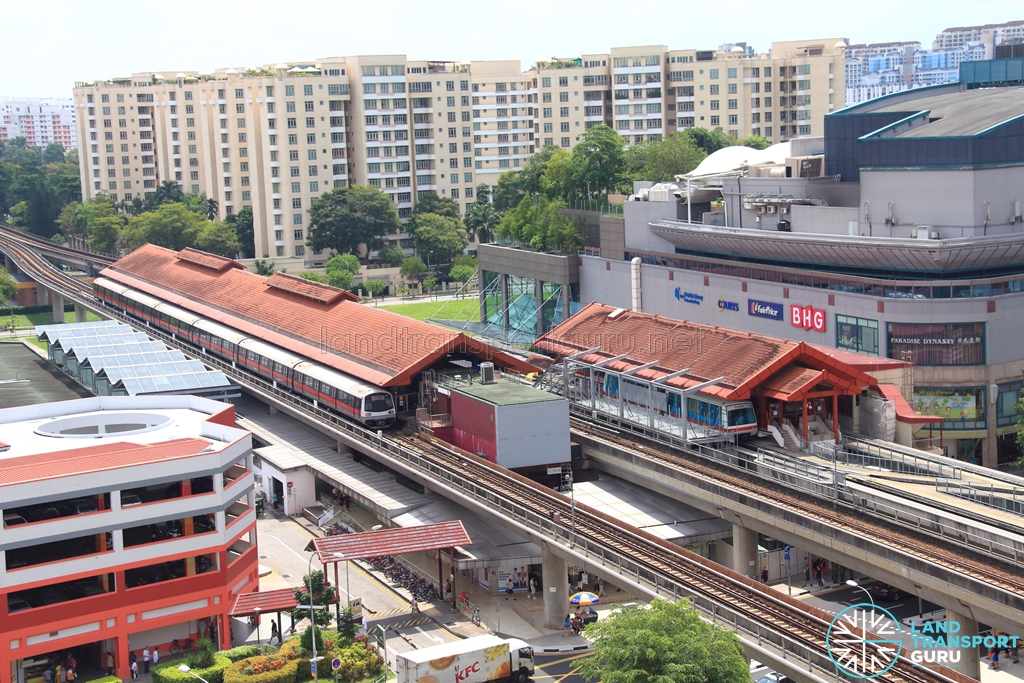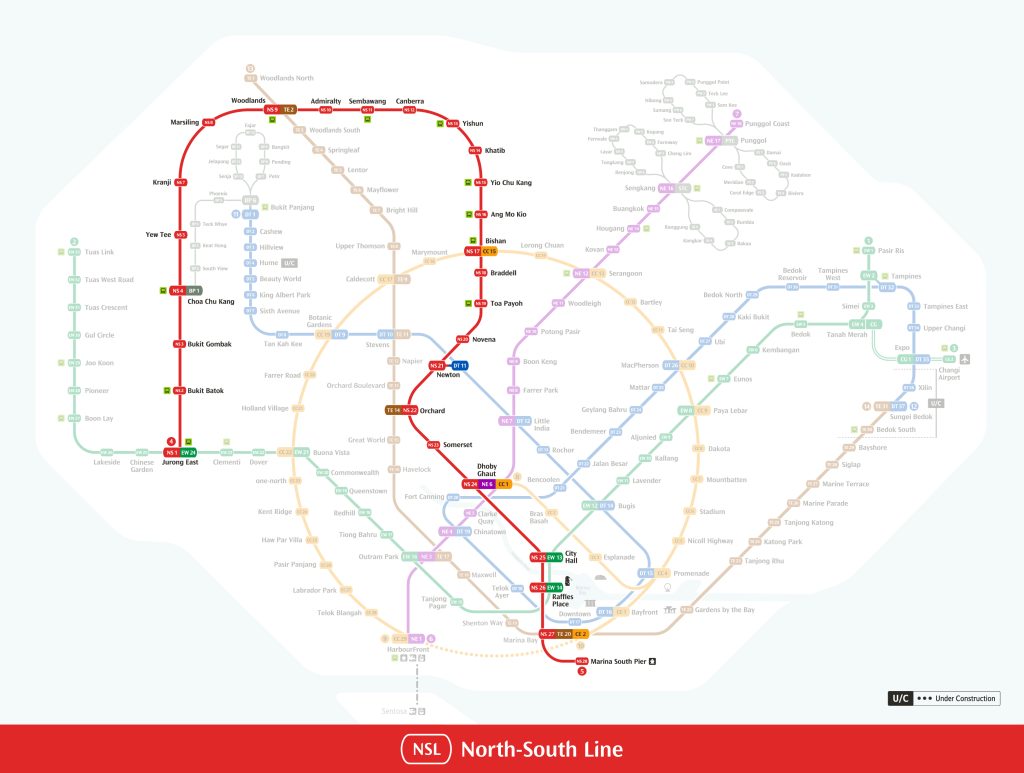| North South Line | |
 |
|
| Type | Mass Rapid Transit (MRT) |
| Station Count | 27 (Operational) 2 (Under planning) |
| Line length | 44 km |
| Termini | Jurong East Marina South Pier |
| Depot | Bishan Depot Ulu Pandan Depot |
| Operational Data | |
| Operators | SMRT Trains |
| Rolling stock | Kawasaki-Sifang C151A Kawasaki-Sifang C151B Kawasaki-Sifang C151C Alstom Movia R151 |
| Electrification | 750 V DC third rail |
| Track gauge | Standard Gauge (1435mm) |
| Opened | Nov 1987 – Nov 1989 (Yishun – Marina Bay) Mar 1990 (Branch Line) Feb 1996 (Woodlands Extension) Nov 2014 (Marina South Pier) Nov 2019 (Canberra) Year 2034 (Brickland) Year 2035 (NS6/DE2 Station Sungei Kadut) |
The North South Line (NSL) is a high capacity MRT line and the first MRT line in Singapore to enter service, connecting the northern and southern regions of the island through Central Singapore. It is currently operated by SMRT Trains.
The NSL is 44km long with 27 stations, running from Jurong East (NS1) in the West to Marina South Pier (NS28) in the South, via Woodlands (NS9) in the North, with station code NS6 reserved for future use (Sungei Kadut). The line runs on elevated viaducts along more than half of its length, and goes underground within the Central Area (between Bishan and Marina South Pier) and along other short sections of its route.
Electric Multiple Unit (EMU) trains on the North South Line operate in a six-car formation, based out of Bishan Depot and Ulu Pandan Depot. The rolling stock is also used on East West Line, which joins the North South Line at Jurong East and Raffles Place / City Hall.
Currently, train services operate between Jurong East and Marina South Pier.
Timeline & History
Detailed: History of the North South Line
- 7 Nov 1987: Yio Chu Kang to Toa Payoh stations opened, the very first section of MRT to commence operations in Singapore
- 12 Dec 1987: Extended south to Raffles Place. Train services would then switch to the East West Line and continue on to Tanjong Pagar and beyond.
- 20 Dec 1988: Extended north to Yishun
- 4 Nov 1989: Extended south to Marina Bay, formal separation of North South Line and East West Line operations
- 10 Mar 1990: Jurong East to Choa Chu Kang opens, as part of the Branch MRT Line
- 10 Feb 1996: Extended north from Yishun to Choa Chu Kang, taking over the Branch Line and terminating at Jurong East
- 23 Nov 2014: Extended south to Marina South Pier
- 2 Nov 2019: Canberra station opens
The original North South Line opened in stages between 1987 to 1989. Yio Chu Kang to Toa Payoh first opened on 7 November 1987, the first section of MRT to open in Singapore. A month later, the line extended south to Raffles Place, where southbound train services would switch lines between City Hall and Raffles Place, and continue along on the East West Line to Tanjong Pagar. The line extended north to Yishun in 1988, and finally extended south to Marina Bay in 1989, with formal separation of North South Line and East West Line operations that same day.
In 1990, Jurong East to Choa Chu Kang stations opened as part of the Branch Line, which were eventually assimilated into the North South Line in 1996 when the Woodlands Extension opened between Yishun and Choa Chu Kang. North South Line services between Jurong East and Marina Bay continued until the opening of the Marina South Pier extension in 2014, although many train services continued to turn around at Marina Bay.
Canberra station opened on 2 November 2019, the second time a station was added to an operational MRT line after Dover station on the East West Line.
Future Plans
In the Land Transport Master Plan 2040, the North South Line will see two new stations to be built by Mid 2030s – Brickland and Sungei Kadut. Sungei Kadut will also be an interchange station with the Downtown Line 2 Extension.
In July 2023, the Land Transport Authority (LTA) announced that construction for Brickland station is expected to commence in 2024 and is targeted for completion in 2034.
LTA officially announced an interchange station as part of the Downtown Line 2 Extension (NS6 / DE2 Station; Sungei Kadut) in January 2025. Construction is expected to commence in Q4 2025, with the stations opening by 2035.
Alignment
The North South Line starts from the western side of Singapore at Jurong East, runs north via Woodlands and turns south via Yishun and through Central Singapore, terminating at Marina South Pier in the South. It passes through major residential towns such as Bukit Batok, Choa Chu Kang, Woodlands, Sembawang, Yishun, Ang Mo Kio, Bishan and Toa Payoh.
Running on a mix of elevated viaducts, at-grade sections and underground tunnels, the line goes underground within the Central Area (between Bishan and Marina South Pier) to avoid building tracks at surface level. A short tunnel between Bukit Batok and Bukit Gombak cuts through a hill, and another short tunnel between Kranji and Marsiling cuts underneath Woodlands Avenue 3. At-grade sections of track lie between Bukit Gombak and Choa Chu Kang, and between Khatib and Yio Chu Kang, the later being between the longest distance between any two MRT stations in Singapore. The only at-grade station on the MRT network is Bishan station, along this line.
Constructed alongside the East West Line (EWL) in the 1980s, both the NSL and EWL share similar technology and rolling stock. Both lines are connected by crossovers at Jurong East and in tunnels between Raffles Place and City Hall. Apart from pre-1989 through-train operations, peak hour NSL through-train services crossing over to eastbound EWL at Jurong East were previously operated, but have since been discontinued.
Improvement works
Full-height Platform Screen Doors (PSDs) were only installed at underground stations since the inception of the NSL. To enhance commuter safety and virtually eliminate the possibility of track intrusion incidents, half-height PSDs (or HHPSDs) were first trialed at Jurong East and Yishun in 2009, followed by a network-wide installation from 2011-2012, covering 36 overground stations across the NSL and EWL.
To mitigate the increased heat and reduced ventilation at overground stations brought about by the HHSPDs, ventilation fans were also installed at all overground stations in 2012. Stations with sufficient headroom received large high-volume low-speed (HVLS) fans, while stations with height constraints received jet fans.
Being the oldest MRT line on the network, the NSL benefitted from major upgrading work carried out in the 2010s. This included sleeper replacement work (which replaced timber sleepers on overground tracks with concrete ones), power supply renewal works, and third-rail replacement works. The most major upgrade lay in re-signalling works costing $195 million, which upgraded the NSL to a Communications-Based Train Control (CBTC) system supplied by Thales, and reduced the minimum interval between trains from the current 120 seconds to 100 seconds.
Testing of the new signaling system began in the late hours of 28 March 2017, during the last hour of revenue service, when all trains were stopped at around 11pm to facilitate the switch to the new system. These tests were carried out over a few days. Full-day weekend testing of the system commenced on 16 April 2017 (Sunday) and continued every Sunday till End-May. Full-day weekday testing of the system commenced on 29 May 2017 (Monday). More detailed information on the CBTC rollout is provided here.
Between 2018 and 2023, noise barriers were also installed along overground track sections in close proximity to residential areas. Noise barriers installed at turnout sections have a semi-enclosed “portal” design to handle the higher noise levels, whereas those along straight tracks are vertical. Phase 1 comprising 11.5 km of barriers was completed in 2018, followed by Phase 2 (10 km; completed in 2020) and Phase 3 (5.5 km, completed in 2023), for a total of 27km of noise barriers.
Line Map
Train Stations
- NS1EW24 Jurong East
- NS2 Bukit Batok
- NS3 Bukit Gombak
- NS4BP1 Choa Chu Kang
- NS5 Yew Tee
- NS7 Kranji
- NS8 Marsiling
- NS9TE2 Woodlands
- NS10 Admiralty
- NS11 Sembawang
- NS12 Canberra
- NS13 Yishun
- NS14 Khatib
- NS15 Yio Chu Kang
- NS16 Ang Mo Kio
- NS17CC15 Bishan
- NS18 Braddell
- NS19 Toa Payoh
- NS20 Novena
- NS21–DT11 Newton
- NS22TE14 Orchard
- NS23 Somerset
- NS24NE6CC1 Dhoby Ghaut
- NS25EW13 City Hall
- NS26EW14 Raffles Place
- NS27CE2TE20 Marina Bay
- NS28 Marina South Pier
Future Stations
Year 2034
- NS3A Brickland
Year 2035
- NS6DE2 Sungei Kadut
Rolling Stock
Electric Multiple Unit (EMU) trains on the North South Line operate in a six-car formation, based out of Bishan Depot and Ulu Pandan Depot. Similar rolling stock is used on the East West Line.
Rolling stock operating on the NSL are:
Trains are maintained at Bishan Depot and Ulu Pandan Depot.
Former rolling stock which have been retired are:
Operations Control Centre
Kim Chuan Depot is the site of SMRT’s Rail Operations Centre, which combines the Operations Control Centres (OCC) of the NSL, EWL and CCL, as well as SMRT’s Maintenance Operations Centre (MOC), under one roof. Prior to 2019, the OCC of NSL and EWL was located at Victoria Street, and its MOC was located at Bishan Depot.
In addition, the Integrated Operations Control Centre houses the standby OCCs for the NSL, EWL, NEL, CCL, DTL and TEL as a fallback measure.
Back to Trains

